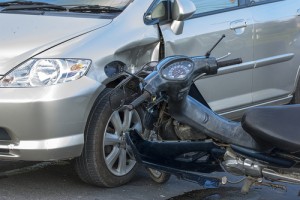This page will discuss Chicago car accident lawsuits. Our Chicago auto accident lawyers will explain some of the main points of law that apply to auto accident injury cases in Illinois. We will also look at the average settlement payout value in Chicago auto accident lawsuits by examining recent verdicts and reported settlements.
Articles Posted in Car Accidents
Uber Rideshare Accident Lawyer
Uber rideshare drivers and their vehicles get into countless car and pedestrian accidents across the country every day. Fortunately, Uber has a liability policy with over $1 million in coverage to compensate rideshare passengers and other drivers. If you are seriously injured due to the negligence of an Uber driver, the accident attorneys at Miller & Zois can help you get the maximum amount of compensation for your injury claim against Uber.
Common Causes of Uber Rideshare Car Accidents
Uber drivers are very commonplace these days. They have basically replaced taxi cabs is most areas of the country. The large number of Uber rideshare drivers on the roads means that they are involved in car accidents with increasing frequency.
Time, Speed and Distance: How Fast Am I Driving
How fast am I driving?
The one thing defendants (and plaintiffs, for that matter) consistently screw up at deposition is time, speed, and distance calculations. They don’t know how fast they are driving and, if they do, they don’t screw it up with their time distance calculation.
- Learn more about crash speed calculations and how they are used in car accident cases
Ford Fusion and Lincoln MKZ Faulty Brake Hose Recall
The National Highway Traffic Safety Administration (NHTSA) has announced a recall affecting nearly 1.3 million Ford Fusion and Lincoln MKZ sedans. These sedans are equipped with faulty brake hoses that could increase the risk of a car accident. Ford has already received a report of a non-lethal crash related to the defect.
The recall includes model year 2013 through 2018 Ford Fusion and Lincoln MKZ vehicles sold in the United States. The front brake hoses in these vehicles may rupture and leak brake fluid, potentially causing braking problems and requiring the driver to apply more pressure than usual to bring the vehicle to a stop.
Ford is sending an interim letter to affected customers on April 17, 2023, and a second letter will be sent once replacement parts are available. Of course, owners will not be charged for replacing the faulty hoses.
The Limits of Uber’s Personal Injury Coverage
 After a night on the town, a taxi is no longer your only option to get back home. Uber, and other “ride-sharing” companies, have given the taxi companies a run for their money by offering cheap(er) and easier transportation. The idea is great: link drivers and those in need of a ride via a smartphone app, allow them to communicate with the tap of a finger, and get rid of on-the-spot payment.
After a night on the town, a taxi is no longer your only option to get back home. Uber, and other “ride-sharing” companies, have given the taxi companies a run for their money by offering cheap(er) and easier transportation. The idea is great: link drivers and those in need of a ride via a smartphone app, allow them to communicate with the tap of a finger, and get rid of on-the-spot payment.
Riders are happy because they can get from A to B cheaper and faster. Drivers are happy because they can earn a living (or extra money) as a cab driver without dealing with the logistics of a cab company which have been historically some of America’s worst run businesses. Of course, Uber is happy too because they make so much profit by brokering the transaction that their company may be worth as much as $40 billion.
Settlement Demand Letter Sample
This is a sample demand letter in a relatively small case with approximately $18,000 in medical bills.
But this personal injury car accident case settled for a lot more money than any kind of simple multiplier of medical bills.
This “times special damages math” where you try to determine a settlement amount with a formula is dangerous. It often causes plaintiffs’ personal injury lawyers (and victims) to substantially undervalue a claim.
- More accident letter samples
- Soft tissue injury cases: the opportunities, challenges, and settlement amounts
What Are My Legal Options if My Car Accident Claim Is Denied?
We buy car insurance hoping we never need to go through the process of submitting a claim. When accidents happen, we hope the claims process is smooth and simple. Seems like a reasonable expectation because you or the at-fault driver paid your premium every month in a way that made it smooth and simple for the insurance company. But it does not work that way, right?
There are several reasons that your claim may be denied. This denial can often cause a significant financial strain on you and your family. . If you’ve recently been in a car accident, you may be counting on the money from the insurance claim to pay medical and other bills.
If your claim has been denied, you need to figure out quickly why and what you can do to get the money you deserve.
Improving Pedestrian Safety By Reviewing Primary Types Of Incidents
One thing I think we can all universally agree on it that there are just too many pedestrian accidents and deaths. Clearly, Chicago is not an exception. A report of pedestrian and vehicle crashes released by Chicago Department of Transportation (CDOT) in 2011, focused on this problem and the types of crashes involving pedestrians. The authors of the study reviewed pedestrian accident data from police reports in the Chicago metropolitan area to determine how each incident occurred.
Is My Motorcycle Accident Covered by My Uninsured Motorist Policy?
 The purpose of uninsured motorist coverage – which most of us blindly have because our state requires it – is so we have protection in the event that we get hit by a driver with no insurance or not enough insurance to provide compensation for our injuries. Most uninsured motorist policies compensate the victim for any amount within the policy limits that would have been recoverable from the at fault driver as money damages resulting from a car collision.
The purpose of uninsured motorist coverage – which most of us blindly have because our state requires it – is so we have protection in the event that we get hit by a driver with no insurance or not enough insurance to provide compensation for our injuries. Most uninsured motorist policies compensate the victim for any amount within the policy limits that would have been recoverable from the at fault driver as money damages resulting from a car collision.
What happens when you are on a motorcycle that is not listed on your insurance policy? Does your uninsured motorist coverage kick in? This issue is usually framed by breaking down the language of the uninsured motorist agreement considers a motorcycle to be an excluded vehicle. But the analysis does not end there. Some states – Maryland is a prime example – is willing to rewrite the terms of an insurance policy to meet public policy objectives. This is done either by judicial fiat or by the state’s uninsured motorist statutory scheme. I’m always telling clients that something in their insurance policy probably in an UM case has been completely rewritten by the General Assembly.
Plaintiffs’ lawyers in these cases argue that the state uninsured motorist laws provides protection that extends not just to the vehicle but to the person. Accordingly, this argument goes, UM coverage is broadly construed to cover all motor vehicle accidents. The insurance companies, argue, on the other hand, that its insured should not be able to have their cake and eat it too by doing someone inherently unsafe while not paying for the coverage. There is merit to both arguments.
Fatal School Bus Accident Prompts Suit Involving Seatbelts
 A fatal school bus accident last week has prompted a lawsuit alleging unsafe conditions for the bus’ lack of seatbelts.
A fatal school bus accident last week has prompted a lawsuit alleging unsafe conditions for the bus’ lack of seatbelts.
The details here are sad. The 60 year old school bus driver and a five-year-old little girl were killed in the crash. The bus, which struck a bridge, was carrying approximately 50 children, ages 5-16.
A suit has now been filed by the family of three of the injured children, with injuries ranging from a broken leg to claims of post-traumatic stress. The suit claims that the bus company failed to inspect the school bus for defective and unsafe conditions, including the lack of seatbelts, though a state police investigation determined that the bus was in fine working condition. The suit further alleges that the company failed to “discover, determine, and /or monitor the health conditions” of the school bus driver, though an autopsy revealed no signs of a medical condition that may have caused the driver to strike the bridge.
This is obviously only one of many more suits to come. The accidental death of anyone, especially a child, prompts frustration and anger, but I’m not sure how the unsafe claim for the bus’ lack of seatbelts will play out.
 Lawsuit Information Center
Lawsuit Information Center

